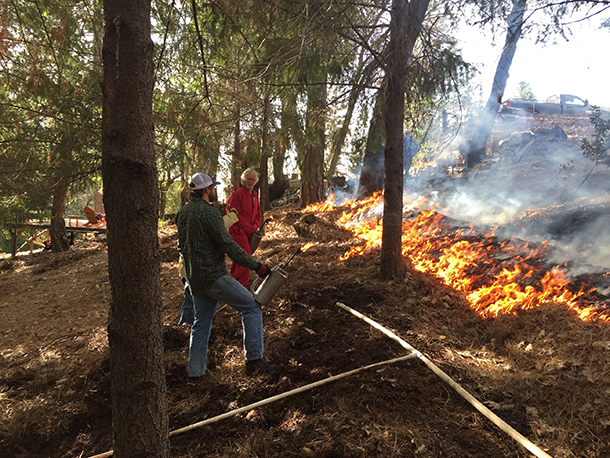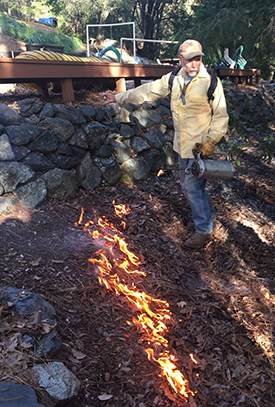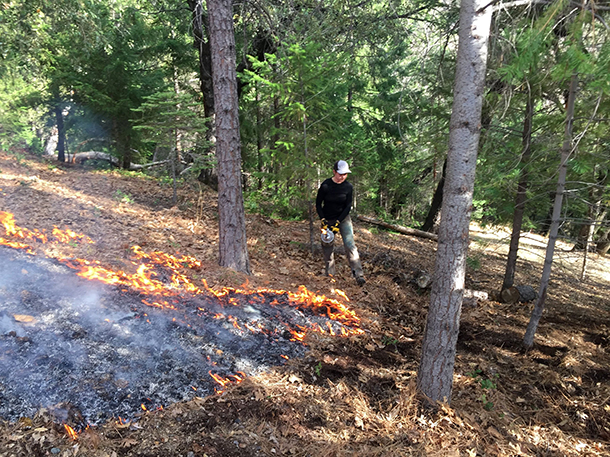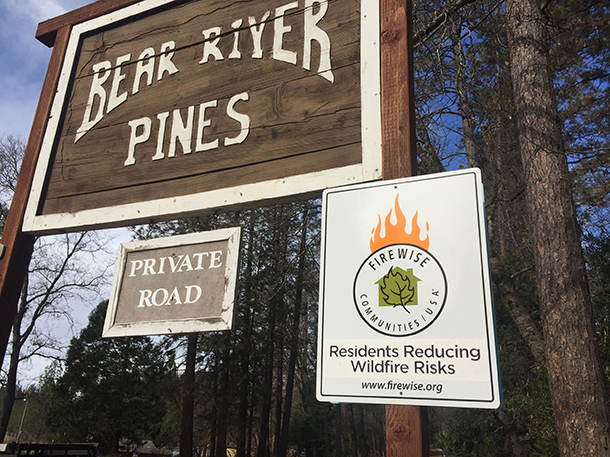Neighborhood Burn Squads Fight Fire With Fire
Air Date: Week of February 8, 2019

Nevada City residents at work on a controlled burn. (Photo: Nathanael Johnson / Grist)
California communities nestled among the forested foothills of the Sierras are vulnerable to wildfire, and some communities are taking steps to reduce their risk. Nathanael Johnson, a senior writer for Grist, witnessed a neighborhood burn squad in action in his hometown of Nevada City, California, and he tells host Steve Curwood about the potential benefits, and risks, of these community-driven controlled burns.
Transcript
CURWOOD: In November 2018, in the wake of the devastating Camp Fire, a town called Paradise looked more like Hell. That burned out California community was just another victim of climate change-fueled wildfire. Now, some Californians who live in fire-prone areas are starting to take matters into their own hands, but very carefully. They’re forming “neighborhood burn squads” teams of residents who learn how to safely set fire to the pine litter and scrub bushes known as chaparral close to their homes. Nathanael Johnson wrote for Grist about one of these grassroots efforts, in Nevada City, California. He joins me now from Berkeley. Nate, welcome to Living on Earth!
JOHNSON: Great to be here, Steve.
CURWOOD: So you grew up in Nevada City. What was that like?
JOHNSON: Nevada City is a beautiful place. It was a great place for me to grow up, as someone who loved the outdoors and liked kayaking down the rivers and climbing on the rocks and that sort of thing. We went backpacking every summer. And we were surrounded by trees, trees were a big part of my childhood. And so were fires. There were a few big fires that really left an imprint on my memories.
CURWOOD: Tell me what it looks like there. People can maybe relate to it in terms of Lake Tahoe, perhaps?
JOHNSON: Yep, it's about halfway between Sacramento and Tahoe. So, you're climbing up into the mountains, but you're not all the way up in the alpine region. So there's a mix of oak hardwoods and Ponderosa pines, and this really red earth, and lots of chaparral growing into the bare spots, which is also a real fire starter.
CURWOOD: So, Nate, you've witnessed one of these neighborhood burns squads in action on a property there in Nevada City, what was that like?
JOHNSON: It was a lot of fun, actually. I went early one morning, it was just after a rain, so things were a little bit damp and cool; the fire wasn't likely to get out of hand because of that. And there's something about fire that just draws people together. It's fascinating. It's warm. And we just watched as the people who had a little more experience with this, set the pine needles on the ground on fire, and felt the warmth coming off of them and watched as it moved along the ground. And they did this very carefully. Fire moves uphill, so they started at the top of the hill and made a little burned strip and then moved a little bit down and made the next burn strip; and just tried to stay out of the smoke and watched as this fire turned this thick layer -- you know, there was about three or four inches of duff on the ground, these leaves and pine needles that you could kick up with the back of your heel. And it would turn the top of that from maybe two inches to just this thin film of ash.
CURWOOD: And how close to houses were these folks doing this burn?
JOHNSON: This was pretty much right up against the house. There was a house about 100 feet away, and it was separated by a rock wall, and we raked clear a little strip next to the wall in hopes of making sure that it didn't jump over and get to the house.
CURWOOD: So who led you in this process? I mean, most people don't know how to do controlled burns, I would guess.
JOHNSON: That's right. This was led by a guy named Dario Davidson, who is a retired forester who's done a lot of controlled burns in his life. Dario is an older gentleman, he's -- white hair and white beard closely cropped. When I got there, he had on his yellow firefighter long-sleeve shirt and really grubby baseball cap and well-worn leather gloves and he was holding this drip can, which is, you know, basically a very low-powered flamethrower, that drips fuel out onto the ground and lights it on fire at the same time.

Dario Davidson is a retired forester who is helping conduct safe controlled burns. (Photo: Nathanael Johnson / Grist)
CURWOOD: Now, what got Dario doing this. I mean, he's out of the forestry business after all.
JOHNSON: So Dario bought about five acres of land nearby where this controlled burn was. And because he was a forester, he knew he had to clear around his house and cut back the underbrush that was growing to protect against fire. And he thought he was doing a great job. But when he started to look at maps of fires, he could see that these big fires, they burned right through. They didn't leave these little gaps of the properties of people who'd done a good job clearing their land. They just burned everything. If you've got enough heat going up, it's just going to set everything on fire. And so he realized that if his preparations were going to count for anything, he had to enlist his neighbors as well. And so he started calling around and got some people together, and figured out a mailing list for the folks in his area, and started organizing, getting people to talk to each other and motivate each other to make their entire community more fire safe.
CURWOOD: Tell me about the physics, really, of where these houses are located and the fire risk that they run.
JOHNSON: So in this area, people move up into these forested communities because they love trees. And a lot of these houses are really nestled in among these dense Ponderosa pines and Douglas firs, which is just a terrible idea when you're in fire country. And so when you have a big fire coming up the hill that's lighting the canopies, that's lighting the tree tops, if you're tucked in among the trees, your house is going to go. Now the fire agencies suggest that you have 100 feet minimum of defensible space that's clear around your house. And if that's the case, you know, you have a fighting chance of saving the house. But it all depends on how hot the fire is. If you have just a massive fire coming up the hill, it's going to throw off enough heat that even 100 feet away it may be hot enough to ignite the house. So that's where these neighborhood solutions really start to matter. If you're reducing the fuels on a neighborhood scale, then there's just less heat overall. And these houses aren't as likely to go up in flames.
CURWOOD: Nate, talk to me about how residents are actually organizing themselves into these burn squads to do the kind of controlled burns that you went and saw.
JOHNSON: This is a, very much a grassroots kind of thing. People are getting together in their living rooms. They're inviting their neighbors over, they're writing letters to people who they don't know but they know their address because they drive by the driveway every day on their way home. And there's some organizations that help with this. So there's something called Firewise Communities, which is a national organization that can help people figure out what to do once they've formed the basics of community organization, what kinds of programs they might want to pursue, and how to get grants to help them chop down the brush and carted out of their properties and that sort of thing.

Because fire moves uphill, the group started at the top of the hill and worked in sections, gradually moving down the hill. (Photo: Nathanael Johnson / Grist)
CURWOOD: So local chapters of this are formed; talk to me about the woman Suzanne you described in your story.
JOHNSON: Suzanne is a member of the Fire Wise Council that I profiled in my story, and I went to this particular one because I was up visiting my mother for Christmas, and she's a neighbor of my mother, this is all very close to home. And Suzanne is just another local landowner who moved to the area knowing that she was moving into a forest, knowing that she'd have to deal with some wildfire risks. And really became acutely aware of this as these big burns started to happen throughout the state, and turned to this local organization that was rising up as a way to prepare -- you know, channel some of that anxiety -- and prepare for what she sees as the inevitable. She told me that for her, it's it's not a matter of if, it's a matter of when there will be a big fire in that area.
CURWOOD: Oh my. So why doesn't she move?
JOHNSON: Well, as she sees it, there's risks all over the country. She lived in a place where there were risks of hurricanes, she lived in another place that was downstream of a big dam that carried a risk for a major flood. So it's kind of hard to get away from risk entirely, especially as the climate changes. Sometimes my wife will ask me, you know, you write about the climate; where should we move to get away from climate risk? And my answer is always, there really isn't any place. Anywhere you're going to be, you're going to have to weigh the risks.
CURWOOD: Now, to what extent do any of the Nevada City residents talk about our changing climate as a factor in wildfires?
JOHNSON: They talk a lot about it. Nevada city is, it's one of those classically hippie and redneck type of mixes. So, you have the old timber economy and the old mining economy, and you have this new wave of people who are moving up, who are artists and who are tech workers working remotely. And they mix together sometimes harmoniously, sometimes less so. But certainly, the new wave of people that are, that were drawn up to the area by this sense that it was this artsy, happening place, are believers in climate change. And there's also just this sense that something is different now. You know, we used to have these big fires once every five or 10 years. And now in the last five years, it's seemed like we've had several fires in the county itself every summer, it seems like recently And then you have these massive fires elsewhere in the West that cast smoke across the sky, and really impact the quality of life for major sections of the population. And that certainly leaves you with the sense that the world is burning down or ending, it really feels apocalyptic. So the recent years have felt truly different when it comes to the fire season. And when people are looking around to see what's changed, they cast their eye toward climate change.
CURWOOD: I imagine there's some practical suggestions, or even some practical trainings that these Firewise Councils do; tell me some of those things.
JOHNSON: Well, they suggest that the members of these communities work together to clear the brush from their land, to teach each other how to make their homes more fire safe. You can do things like switching out the wooden shakes on your roof for aluminum roofing or asphalt tiles; you can clear a sort of a meadow around your house, rather than having kind of a dense forest right up to the walls. So there's all these sort of just basic education. And then there's also this motivation to create a plan. So what do you do when a big fire comes? If you have one day to evacuate, how much are you going to pack? What are the things you're going to throw into the car? If you have one hour to evacuate, who are you going to call, what are the things you're going to throw into the car? And these are the kinds of things that, if you have a plan, if you have something written down, it's a lot easier to remember and to do it correctly. So Suzanne showed me her copy of her plan. And it was just really impressive, you know, these things that I wouldn't have thought of, like turning off the electric garage door so that it could be opened by hand, if firefighters needed to get in there and the lines were down.

Firewise associations are popping up all over Nevada County in California (Photo: Nathanael Johnson / Grist)
CURWOOD: So what's the level of concern that folks might carelessly try to do their own controlled burns without the proper experience or knowledge?
JOHNSON: I think there's a lot of concern about that. If people are just setting things on fire, the results are going to be catastrophic. And the reason that this particular controlled burn worked and was so safe and so manageable was that, you know, maybe three or five years back people had already come in and taken out the underbrush. So we're really just talking about this layer of pine needles that was burning. If you go to an overgrown lot somewhere in Nevada County that hasn't been treated and you think "well, I don't want to do all this hard work, cutting back the Manzanita and pulling out the Scotch broom, I'll just set this on fire," you're going to create a major forest fire. So even people like Dario Davidson, who was saying, look, really what we need to do is these repeated, small, slow, controlled burns and reduce the fuels -- even he was saying, I don't really know if I want individual landowners just doing this for themselves. We really need to make sure that for every one of these, there's someone there that has done it before and knows what they're doing and signs off on it.
CURWOOD: Nathanael Johnson is a senior writer for Grist. Thanks so much for taking the time today, Nate.
JOHNSON: Thank you for having me. I appreciate it.
Links
Grist | “Friendly Fire: Can neighborhood burn squads save California from the next big wildfire?”
New York Times | “Climate Change Is Fueling Wildfires Nationwide, New Report Warns”
Living on Earth wants to hear from you!
Living on Earth
62 Calef Highway, Suite 212
Lee, NH 03861
Telephone: 617-287-4121
E-mail: comments@loe.org
Newsletter [Click here]
Donate to Living on Earth!
Living on Earth is an independent media program and relies entirely on contributions from listeners and institutions supporting public service. Please donate now to preserve an independent environmental voice.
NewsletterLiving on Earth offers a weekly delivery of the show's rundown to your mailbox. Sign up for our newsletter today!
 Sailors For The Sea: Be the change you want to sea.
Sailors For The Sea: Be the change you want to sea.
 The Grantham Foundation for the Protection of the Environment: Committed to protecting and improving the health of the global environment.
The Grantham Foundation for the Protection of the Environment: Committed to protecting and improving the health of the global environment.
 Contribute to Living on Earth and receive, as our gift to you, an archival print of one of Mark Seth Lender's extraordinary wildlife photographs. Follow the link to see Mark's current collection of photographs.
Contribute to Living on Earth and receive, as our gift to you, an archival print of one of Mark Seth Lender's extraordinary wildlife photographs. Follow the link to see Mark's current collection of photographs.
 Buy a signed copy of Mark Seth Lender's book Smeagull the Seagull & support Living on Earth
Buy a signed copy of Mark Seth Lender's book Smeagull the Seagull & support Living on Earth

